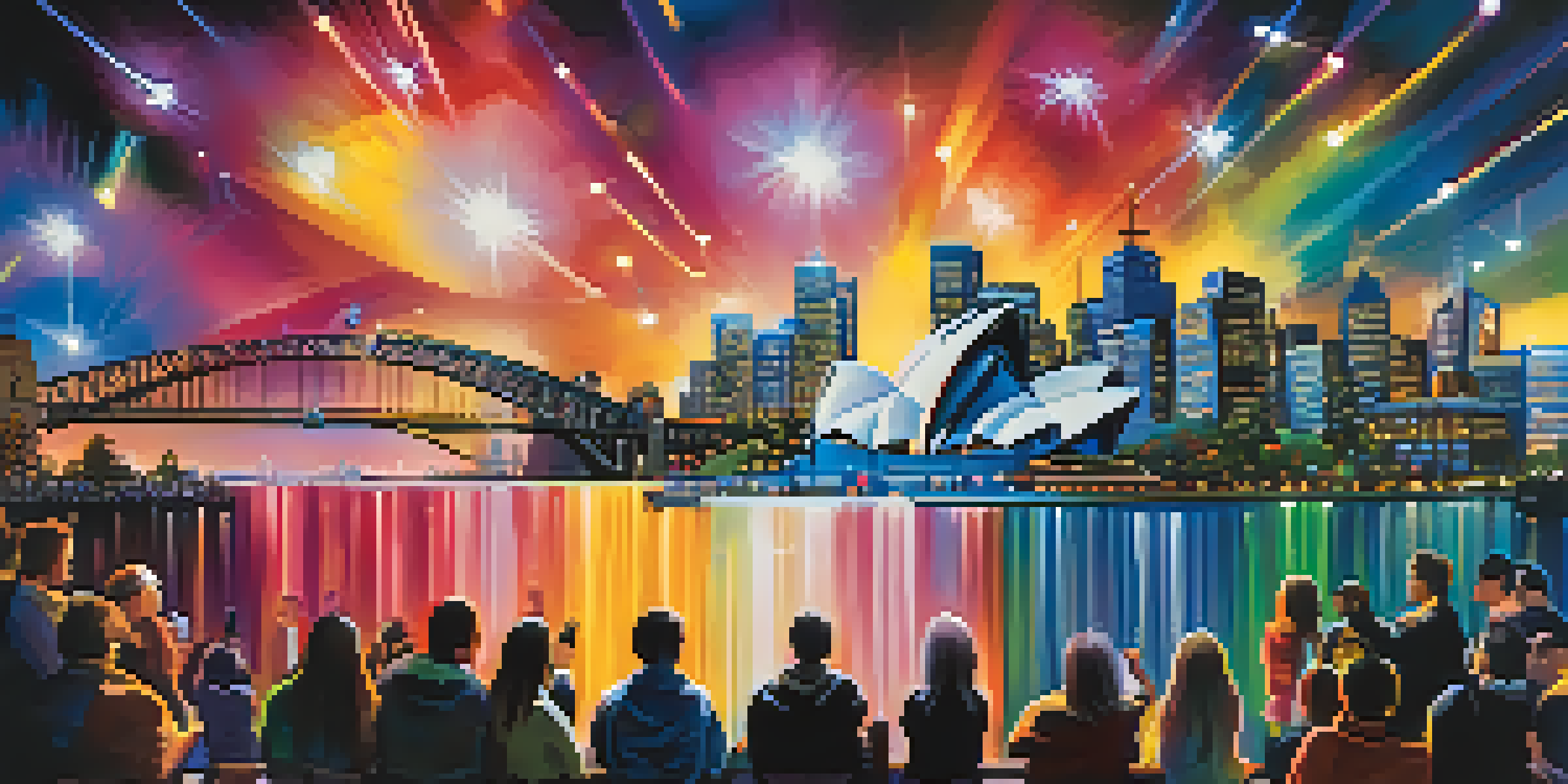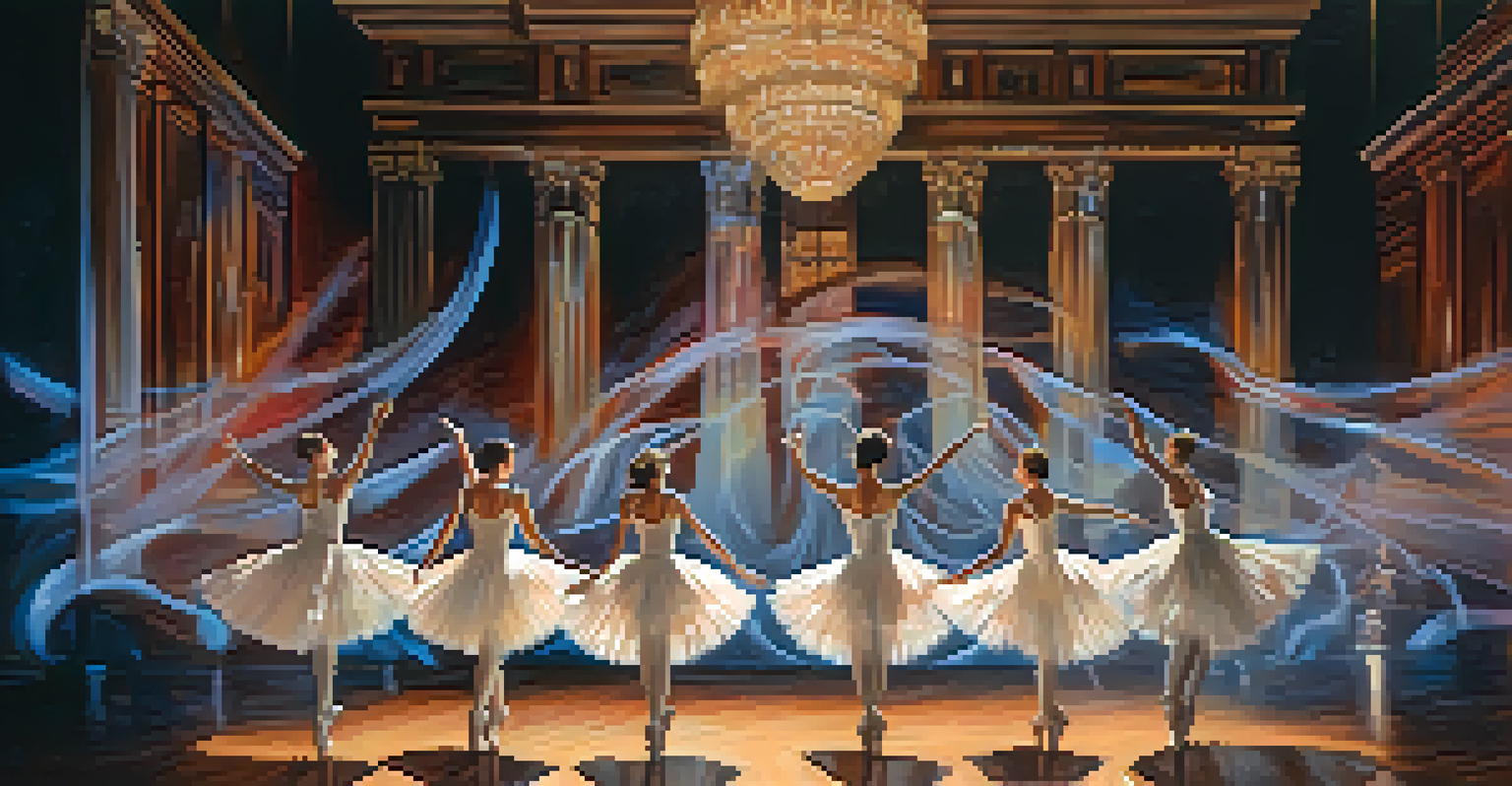Case Studies: Successful Visual and Sound Art Collaborations

The Power of Collaboration in Art: An Overview
Collaboration in art can be a magical experience, blending different mediums to create something entirely new. Visual and sound artists often find that working together expands their creative horizons, resulting in immersive experiences that captivate audiences. This synergy not only enhances the artistic expression but also fosters innovation through the merging of ideas and techniques.
Art is the most beautiful of all lies.
For instance, consider how a visual artist might use projections to bring their paintings to life, while a sound artist adds layers of audio that resonate with the visual elements. This partnership can transform a simple exhibit into an engaging spectacle, inviting viewers to experience art in a multi-dimensional way. The collaborative process encourages artists to push boundaries, leading to exciting results.
Ultimately, the beauty of collaboration lies in its potential to create unique narratives that resonate on multiple levels. By combining strengths and ideas, artists can craft experiences that leave lasting impressions, proving that the whole can indeed be greater than the sum of its parts.
Case Study: Light and Sound Festival in Sydney
One of the most celebrated examples of successful collaboration is the annual Vivid Sydney festival, where visual artists and musicians unite to transform the city into a canvas of light and sound. During the festival, iconic landmarks are illuminated with stunning projections, while live music performances enhance the atmosphere, creating a truly immersive experience for attendees. This innovative approach not only attracts tourists but also fosters a sense of community among local artists.

The festival features installations that harmonize light displays with soundscapes, encouraging visitors to explore the relationship between the two mediums. For example, a piece may combine synchronized light patterns with a live orchestral performance, creating a dynamic interplay that captivates the audience. This collaboration showcases how visual and auditory elements can complement each other, resulting in an unforgettable experience.
Art Thrives in Collaboration
Collaboration among artists enhances creativity and leads to innovative experiences that engage diverse audiences.
Vivid Sydney exemplifies how collaborative efforts can elevate art to new heights, turning the city into a vibrant playground of creativity. It serves as a reminder of the power of partnerships in art, where diverse talents come together to inspire and engage, ultimately making art more accessible to everyone.
Case Study: The New York Sound Art Festival
Another notable example is the New York Sound Art Festival, which brings together sound artists and visual creators to explore the intersections of their crafts. This annual event features a range of performances and installations that highlight how sound can alter visual perception and vice versa. Artists collaborate to create works that challenge traditional boundaries and encourage participants to engage with both sound and sight in new ways.
The best artist has no conception that a marble block does not contain within itself.
For example, one installation might involve a visual artist creating a series of sculptures that respond to live audio input. As the sound changes, the sculptures morph in real time, creating an interactive experience for the audience. This type of collaboration highlights the dynamic relationship between visual and sound art, illustrating how one can enhance and transform the other.
The New York Sound Art Festival not only showcases individual talents but also fosters a community of artists eager to experiment and innovate. By encouraging these collaborations, the festival becomes a platform for exploration, allowing audiences to experience art that resonates on multiple sensory levels.
Case Study: The Intersection of Dance and Visual Art
One fascinating collaboration occurs at the intersection of dance, visual art, and sound, where artists combine their talents to create holistic performances. A prime example is a project where choreographers and visual artists work together to design a stage that reacts to dancers' movements, while musicians create an accompanying score that reflects the visual elements. This multi-layered approach elevates the performance, making it a rich sensory experience.
In such performances, the visual art can include live projections or interactive elements that respond to the dancers, heightening the emotional impact of the piece. For instance, as a dancer moves, the visuals might shift in color or form, synchronized with the rhythm of the music. This creates a seamless dialogue between the three disciplines, ensuring that each element enhances the others.
Festivals Showcase Collaborative Art
Events like Vivid Sydney exemplify how visual and sound art collaborations can transform urban spaces into immersive artistic experiences.
These collaborations break down the barriers between different art forms, allowing for a more integrated and engaging experience. They remind us that art is not confined to a single medium; rather, it thrives in the convergence of diverse expressions, inviting audiences to see, hear, and feel in new and exciting ways.
Case Study: Interactive Installations at Art Shows
Interactive art installations often serve as a perfect example of successful collaboration between visual and sound artists. At various art shows around the world, installations invite audiences to engage with both sight and sound, creating an immersive environment that encourages exploration. For example, one installation might feature a series of visual displays that change based on the sounds made by visitors, creating a feedback loop that enhances the experience.
Such installations not only draw people in but also allow them to become part of the artwork itself. As visitors interact, their actions influence the visual and auditory elements, making each experience unique. This collaboration emphasizes the importance of audience engagement and demonstrates how art can evolve through interaction.
By harnessing technology and creativity, these interactive installations challenge traditional notions of art consumption. They invite audiences to actively participate in the artistic process, reinforcing the idea that collaboration can lead to innovative and memorable experiences that resonate long after the event.
Case Study: The Role of Technology in Art Collaborations
Technology has revolutionized the way visual and sound artists collaborate, opening up new avenues for creativity. With tools like software for visual mapping and sound design, artists can work together in ways that were previously unimaginable. This allows for real-time collaboration, where changes to a visual piece can instantly affect the soundscape and vice versa, creating a fluid artistic dialogue.
An example of this can be seen in live performances where artists use technology to create immersive environments. By utilizing projection mapping alongside live sound mixing, they can craft a seamless experience that engages all the senses. This synergy not only captivates audiences but also pushes the limits of artistic expression, encouraging artists to explore uncharted territories.
Technology Shapes Artistic Partnerships
The integration of technology in art collaborations allows for real-time interaction, creating dynamic and engaging environments.
The integration of technology into collaborative art forms highlights the exciting possibilities that emerge when different mediums intersect. It serves as a reminder that innovation often arises from the fusion of ideas and disciplines, leading to experiences that are both captivating and thought-provoking.
The Future of Visual and Sound Art Collaborations
As we look to the future, the potential for visual and sound art collaborations continues to expand. Artists are increasingly embracing interdisciplinary approaches, breaking down barriers and exploring new ways to express their creativity. This trend not only enriches the art world but also enhances audience engagement, making art more accessible and relatable.
Emerging technologies, such as virtual and augmented reality, are set to play a significant role in these collaborations. Imagine walking through an art installation where the visuals change based on your movement and the sound adapts to your location. These immersive experiences will redefine how we interact with art and deepen our understanding of the relationship between different mediums.

The future is bright for visual and sound art collaborations, as artists continue to innovate and inspire. By embracing new technologies and fostering partnerships, they can create experiences that resonate with audiences and push the boundaries of what art can be. As we move forward, it will be exciting to see how these collaborations evolve and shape the artistic landscape.